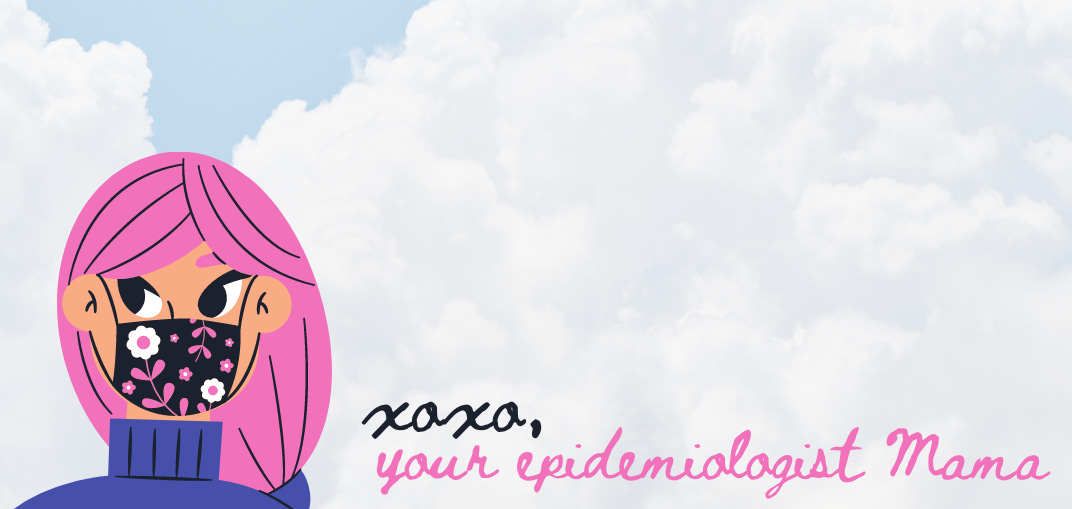State of the Pandemic
On Tuesday, President Biden gave his State of the Union address in person at the Capitol. While the pandemic was mentioned during his speech, it was overshadowed by the events taking place in Ukraine, inflation, rising prices of gasoline, and infrastructure (among other things).
I believe a State of the Pandemic report/speech is needed.
So please — imagine me at the podium in my blue turtleneck, grey jacket, black pants, and blue converse All-Stars (ala Kamala Harris). Here goes…
The State of the Pandemic — March 4, 2022
Friends — it has been a long two years. When word of a rare form of pneumonia and then a novel coronavirus began to spread in late 2019, most of us assumed it was SARS again; a deadly virus that could, with adequate monitoring and quality isolation, be controlled. It started as merely a topic for discussion on a slow evening of news. We thought it was nothing to fear or worry about. We never expected it to up-end our lives for multiple years.
As more information about SARS-CoV-2 and the disease it causes (COVID-19) became available in January of 2020, public health professionals (myself included) became more concerned, and our anxiety and worry increased as the items on the public health “worst-case scenario” checklist were quickly checked off and a full-blown, airborne pandemic was upon us.
Unfortunately as of today (more than 2 years later), more than 1700 people in the United States are dying every day from COVID-19. And children aged 0-4 years old still do not have access to a COVID vaccine. However, the number of cases in the United States has dropped by 55% (over the past two weeks); globally cases have decreased by 24%. Hospitalizations have decreased by 43% in the US, and the number of deaths is also decreasing by 26% (though too many people are dying from a vaccine-preventable disease).
The Omicron surge that began at Thanksgiving is slowing. With just a few weeks until the start of spring, we are all hoping to move into this new season with more sunshine, warmer temperatures, and less disease. As we step into a new season — of the year and of the pandemic — there are three truths that we must all cling to:
The ONLY constant is change.
There is no absolute right or absolute wrong.
COVID is a vaccine-preventable disease.
No one has a crystal ball.
We cannot predict the future of the SARS-CoV-2 virus, but we should expect the virus to continue to evolve and new variants to emerge (change is our only constant). Everyone must learn to expect the virus to change, and public health needs to develop surveillance and communications systems to track the disease and explain the steps that we can all take to mitigate disease spread. COVID is here to stay. As we imagine a future where COVID is an endemic disease, we need to understand that endemic does NOT mean the end. Instead, it means we learn to live in equilibrium with the virus. This means that there is enough immunity in the population to prevent an outbreak (or another wave of disease), but it continues to spread in our community because there are still susceptible individuals among us. We should expect that we will be exposed and we may become ill in the future, but our vaccines will keep us out of the hospital and the morgue.
We are all hoping the next variant will cause milder disease and that our current vaccines will be effective at preventing severe disease. But this is not guaranteed. We can only be assured the virus will change in the future, and we will have to respond to those changes.
There is no absolute right or absolute wrong.
As we move into the next stage of the pandemic with decreasing community spread, we are not simply flipping a switch and saying “now, the community is safe from COVID.”
Life is not dichotomous; it is not binary.
We are transitioning, like a light on a dimmer switch. The lights have not been turned off; they are just decreasing in intensity.
COVID is still spreading, as are influenza, norovirus, RSV, and lice.
We need strategies to mitigate the spread of disease. We need a robust public health system that makes the best use of 21st-century technology. We need public health to step up and provide clear guidance as well as services such as case investigations, contact tracing, quarantining, and isolation. We cannot demand that our schools, churches, and local governments do all of this work for them. We need to recruit, retain, train, and empower a strong and mighty public health workforce to do all the work of public health and to lead through times of health and emergency.
Vaccines are SO IMPORTANT
Vaccines prevent severe illness and death caused by COVID-19. Individuals who are unvaccinated are 41 times more likely to die from COVID-19 compared to individuals who are vaccinated and boosted, and 23 times more likely to be hospitalized.
Omicron has been a game-changer in many ways (remember, the only constant is change). Omicron has (unfortunately) reduced the effectiveness of the vaccines against infection, especially among individuals who received one shot of the Johnson & Johnson vaccine or were vaccinated five or more months ago. This is because the protective antibodies that can quickly identify and destroy the first sign of the virus in the body wane over time. Additionally, the 36 mutations to omicron’s spike protein — which all three of the vaccines target — have made antibodies somewhat less able to neutralize the virus.
At this point in the pandemic, policies stating that an unvaccinated person should mask when vaccinated individuals do not need to mask are NOT an appropriate risk reduction strategy. If two COVID+ individuals walk into a room and one is vaccinated and the other is not — the risk profile is the same for both individuals; they are both going to spread their disease to others. Similarly, if organizations or agencies are continuing to quarantine exposed individuals, in light of what we know about Omicron, all close contacts regardless of vaccination status should be required to quarantine. Everyone is susceptible to disease regardless of vaccination status while Omicron is circulating.
Vaccines prevent severe illness and death. But their effectiveness at preventing infections is limited. We should encourage everyone to get vaccinated — to save them from severe illness or death and to decrease the stress on our healthcare system. But policies that allow for vaccinated individuals to skip quarantine or remove their masks (while unvaccinated individuals are required to follow those policies) are ineffective and inappropriate given the Omicron variant.
And these types of policies divide us as the vaccinated and the unvaccinated at a time when we need to come together.
The time has come to take steps forward together against the SARS-CoV-2 virus (NOT each other) in order to create healthy communities. In order to do it, we must start by adopting a shared mission to love our neighbors. We must care for each other and work collectively to slow the spread of all infectious diseases. To do this, we must all agree to the following —
Stay home when you are sick.
While you might be able to go to work and push through with a cold, stay home. Keep your germs to yourself. Do not expose others; stop the chain of transmission from person to person. This also means we must also keep our kids out of school when they are sick.Wear a mask if you must go to work or school when you are sick.
Encourage people to seek out COVID testing and treatment.
Do not make fun of someone or out them for testing positive for COVID. Or the flu. Or for having lice. These are infectious diseases; they are not a joke nor should we be gossiping about them. Diagnosing an illness allows for proper treatment and slows the spread of disease. Let’s work to create a healthcare system where seeking testing, getting diagnosed, and receiving treatment and instructions for isolation are the basic tenants of the healthcare system and the rights of all individuals.Recognize the amount of stress we have experienced individually and as a community during the past two years. As we transition into a time of low case counts, I would encourage us to lower our defenses (read: take our masks down) gradually. And for those of us who are vaccinated, let’s trust our vaccines. That they will protect us from severe illness and death. And at the same time, let’s be slow in our responses to changing policies, schools adopting new practices, and friends and neighbors who may be removing their masks in certain situations as they feel comfortable. Let’s be supportive and loving toward our neighbors, friends, community leaders, teachers, and school nurses, among others.
Spring is a time of rejuvenation. Of fresh starts. Of rebirth. Of new growth.
I would encourage all of us (I’m speaking to myself here) to try and embody the spirit of springtime. Take small steps if you must, but take a step into this new season of the pandemic. While case counts and hospitalizations are low — I would encourage all of us to find activities to reduce the stress caused by COVID and that bring us joy!
I would suggest that you — remove your mask when there are only 4 others in your yoga class; breathe deeply. Go to the local coffee shop with a friend, sit down at a table, remove your mask, and enjoy your favorite drink. Make a reservation at a restaurant for 5 pm on a Saturday before the rush. Enjoy a meal out with your loved ones. Or invite a friend to your house for a glass of wine and enjoy their company without masks or fear of illness (assuming you are both feel good the day of).
As I think about finding joy and new beginnings in this new season of the pandemic, I am reminded of the words of William Martin —
“Do not ask your children
to strive for extraordinary lives.
Such striving may seem admirable,
but it is the way of foolishness.
Help them instead to find the wonder
and the marvel of an ordinary life.
Show them the joy of tasting
tomatoes, apples and pears.
Show them how to cry
when pets and people die.
Show them the infinite pleasure
in the touch of a hand.
And make the ordinary come alive for them.
The extraordinary will take care of itself.”
We could easily rewrite this as a reminder and inspiration for ourselves —
Do not ask yourself
to strive for the extraordinary (or the extreme).
Such striving may seem admirable,
but it is the way of foolishness.
Help yourself instead to find the wonder
and the marvel of an ordinary life (even with COVID circulating).
Remember the joy of tasting
tomatoes, apples and pears.
Remember that it is okay to cry
when pets and people die.
Remember the infinite pleasure
in the touch of a hand (or the hug of a friend you’ve been distanced from).
And make the ordinary come to life for yourself and those you love.
The extraordinary will take care of itself.





